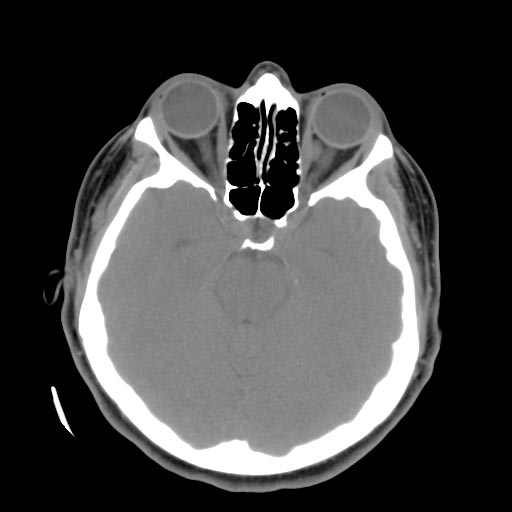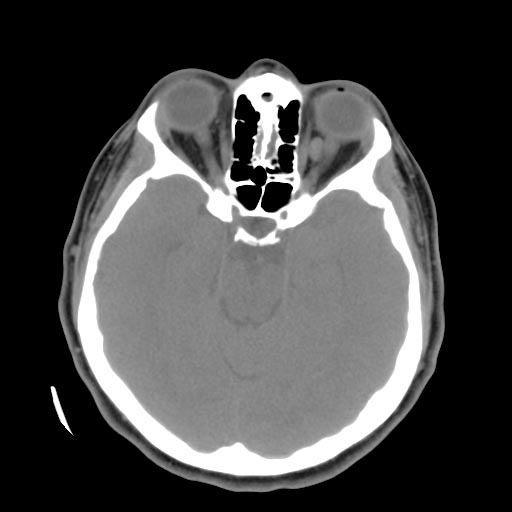Cavernous angioma CT: Difference between revisions
Jump to navigation
Jump to search
No edit summary |
|||
| (7 intermediate revisions by 3 users not shown) | |||
| Line 3: | Line 3: | ||
{{CMG}}, {{AE}} [[User:Edzelco|Edzel Lorraine Co, D.M.D, M.D.]] | {{CMG}}, {{AE}} [[User:Edzelco|Edzel Lorraine Co, D.M.D, M.D.]] | ||
==Overview== | |||
[[CT scan]] is not usually used as a primary modality to diagnose [[cavernous angiomas]] due to the inability to detect smaller [[lesions]], despite the ability to detect lesions complicated by [[calcification]] or [[hemorrhage]]. | |||
==CT Scan== | ==CT Scan== | ||
CT scan is not usually used as a primary modality to diagnose cavernous angiomas due to | [[CT scan]] is not usually used as a primary modality to diagnose [[cavernous angiomas]] due to the inability to detect smaller [[lesions]], despite the ability to detect [[lesions]] complicated by [[calcification]] or [[hemorrhage]].<ref name="pmid23408355">{{cite journal| author=Liu XW, Wang SH, Chi ZF, Su LJ, Zhao XH, Wang SJ| title=The value of T(2) (*)-weighted gradient echo imaging for detection of familial cerebral cavernous malformation: A study of two families. | journal=Exp Ther Med | year= 2013 | volume= 5 | issue= 2 | pages= 448-452 | pmid=23408355 | doi=10.3892/etm.2012.845 | pmc=3570237 | url=https://www.ncbi.nlm.nih.gov/entrez/eutils/elink.fcgi?dbfrom=pubmed&tool=sumsearch.org/cite&retmode=ref&cmd=prlinks&id=23408355 }} </ref> | ||
'''Left Orbital Cavernous Hemangioma''' | '''Left [[Orbital]] Cavernous Hemangioma''' | ||
<gallery> | <gallery> | ||
File:Orbital-hemangioma-001.jpg | File:Orbital-hemangioma-001.jpg | ||
| Line 20: | Line 22: | ||
[[Category:Genetic disorders]] | [[Category:Genetic disorders]] | ||
[[Category:Dermatology]] | [[Category:Dermatology]] | ||
[[Category: | [[Category:Up to Date]] | ||
Latest revision as of 21:54, 25 April 2022
|
Cavernous angioma Microchapters |
|
Diagnosis |
|---|
|
Treatment |
|
Case Studies |
|
Cavernous angioma CT On the Web |
|
American Roentgen Ray Society Images of Cavernous angioma CT |
Editor-In-Chief: C. Michael Gibson, M.S., M.D. [1], Associate Editor(s)-in-Chief: Edzel Lorraine Co, D.M.D, M.D.
Overview
CT scan is not usually used as a primary modality to diagnose cavernous angiomas due to the inability to detect smaller lesions, despite the ability to detect lesions complicated by calcification or hemorrhage.
CT Scan
CT scan is not usually used as a primary modality to diagnose cavernous angiomas due to the inability to detect smaller lesions, despite the ability to detect lesions complicated by calcification or hemorrhage.[1]
Left Orbital Cavernous Hemangioma
References
- ↑ Liu XW, Wang SH, Chi ZF, Su LJ, Zhao XH, Wang SJ (2013). "The value of T(2) (*)-weighted gradient echo imaging for detection of familial cerebral cavernous malformation: A study of two families". Exp Ther Med. 5 (2): 448–452. doi:10.3892/etm.2012.845. PMC 3570237. PMID 23408355.

